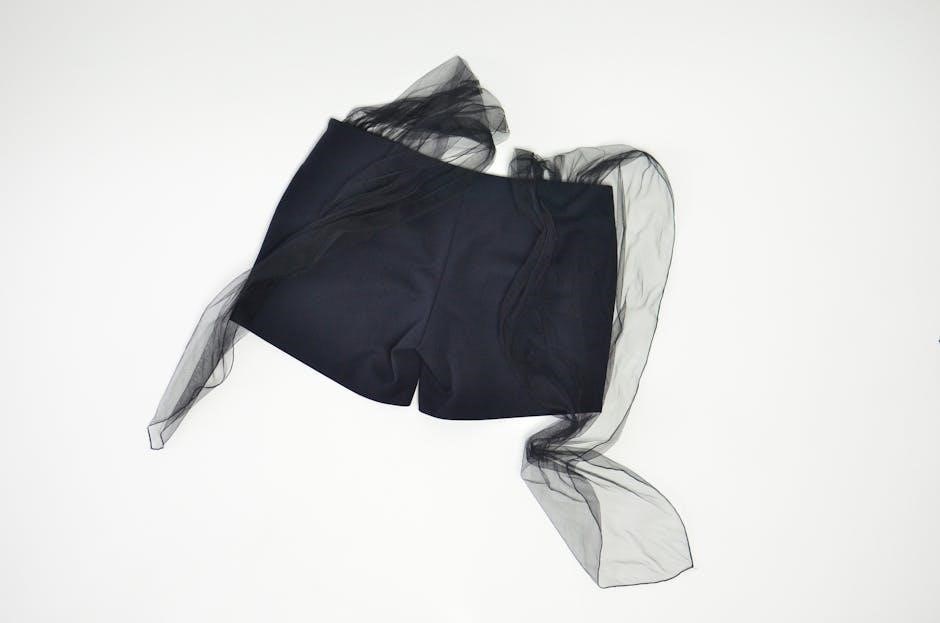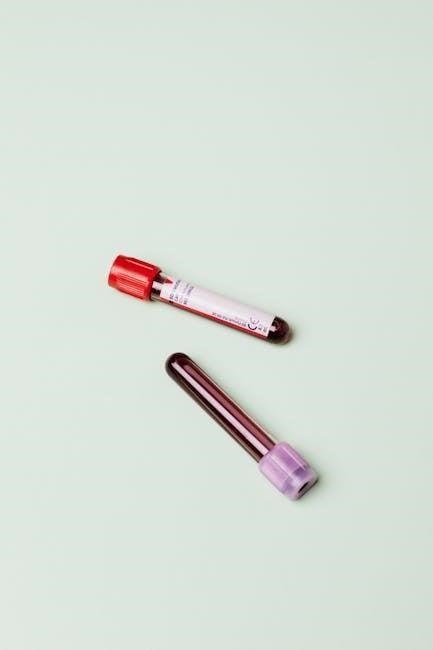color guide blood collection tubes
Blood collection tubes are color-coded to ensure accurate testing and patient safety. Each color represents specific additives or preservatives, guiding phlebotomists in proper sample collection.
Importance of Color Coding in Blood Collection
Color coding on blood collection tubes is vital for ensuring accurate test results and patient safety. Each tube color corresponds to specific additives or preservatives, guaranteeing the right sample is used for the correct test. This system prevents errors in specimen collection, which could lead to incorrect diagnoses or delayed treatment. By standardizing tube identification, color coding streamlines the testing process, reducing mix-ups and improving efficiency in laboratories. It also helps phlebotomists quickly identify the appropriate tube for each test, minimizing confusion and ensuring compliance with medical protocols. Accurate blood collection is foundational to reliable diagnostic outcomes, making color coding an essential tool in healthcare.
Overview of Common Tube Colors and Their Uses
Blood collection tubes are categorized by color to indicate their specific use and additives. Lavender tubes contain EDTA for hematology tests, while light blue tubes use sodium citrate for coagulation. Red tubes have no additive, making them suitable for serum separation. Gold tubes include a gel separator for serum tests, and green tubes use lithium heparin for plasma collection. Yellow tubes are for blood cultures with SPS, and pink tubes contain K2 EDTA for blood typing. Pearl tubes have no additive but include gel, and tan tubes use EDTA for hematology and blood bank tests. Gray tubes contain sodium fluoride and potassium oxalate, black tubes have no additive for special tests, and royal blue tubes use sodium heparin for trace metal analysis. Each color ensures the correct additive is present for accurate testing.

Understanding Different Blood Collection Tubes by Color
Blood collection tubes are color-coded to identify their specific additives and uses. Each color corresponds to a particular test or procedure, ensuring accurate sample collection and analysis.
Lavender Top Tubes: EDTA for Hematology Tests
Lavender top tubes, containing EDTA, are used for hematology tests, such as CBCs. EDTA prevents clotting by binding calcium ions, preserving blood cells for accurate analysis. Proper mixing is essential to ensure reliable results. These tubes are commonly used in routine blood exams to assess various blood components, including red and white blood cell counts. Ensuring the correct order of draw and handling procedures is crucial to maintain sample integrity and avoid testing errors. Lavender tubes are a fundamental component in clinical settings for diagnosing and monitoring hematological conditions. Their widespread use underscores their importance in modern healthcare diagnostics.
Light Blue Top Tubes: Sodium Citrate for Coagulation Tests
Light blue top tubes contain sodium citrate, an anticoagulant that prevents clotting by binding calcium ions. These tubes are specifically used for coagulation tests, such as PT, INR, and APTT, which measure blood clotting factors. Sodium citrate ensures accurate test results by maintaining the blood’s coagulation profile. Proper tube filling and mixing are critical to avoid errors. Light blue tubes are essential in diagnosing bleeding disorders and monitoring patients on anticoagulant therapy. Their precise use is vital for reliable coagulation studies, making them a cornerstone in hemostasis testing and patient care.
Red Top Tubes: No Additive for Serum Separation
Red top tubes are designed for serum separation and contain no additives or anticoagulants, allowing blood to clot naturally. After centrifugation, the serum is used for various clinical chemistry tests, such as liver function, electrolytes, and glucose levels. These tubes are ideal for tests requiring serum without interference from additives. Proper collection involves filling the tube completely to ensure adequate clotting and separation. Red top tubes are widely used in routine lab testing, providing clear serum samples essential for accurate diagnostic results. Their simplicity makes them a standard choice for many common blood tests, ensuring reliable outcomes for patient care and monitoring.
Gold Top Tubes: Serum Separator with Gel
Gold top tubes, also known as serum separator tubes (SST), contain a gel barrier and no additives. After blood collection, the tube is centrifuged, allowing the gel to rise and separate the serum from blood cells. This ensures clear serum samples for accurate lab testing. These tubes are commonly used for routine chemistry tests, such as liver function, glucose, and electrolyte panels. The gel barrier prevents cellular interference, making gold top tubes a preferred choice for serum testing. They are easy to use and provide reliable results, making them essential in clinical settings for various diagnostic procedures requiring serum samples.
Green Top Tubes: Lithium Heparin for Plasma
Green top tubes contain lithium heparin, an anticoagulant that prevents blood clotting without affecting plasma composition. These tubes are used for collecting plasma samples, which are essential for various clinical tests, including electrolyte panels, renal function tests, and liver function tests. Lithium heparin is preferred for its ability to inhibit clotting effectively while maintaining the integrity of plasma components. After collection, the tube should be mixed thoroughly by inverting it 8-10 times to ensure the anticoagulant is well distributed. Green top tubes are a popular choice for plasma-based testing due to their reliability and minimal interference with test results, making them a valuable tool in diagnostic workflows.
Yellow Top Tubes: SPS for Blood Cultures
Yellow top tubes contain Sodium Polyanethol Sulfonate (SPS), an anticoagulant that prevents clotting and inhibits microbial growth, making them ideal for blood culture testing. These tubes are used to detect infections, such as bacteremia or fungemia, by identifying pathogens in the blood. Blood cultures are typically collected before other tubes to avoid contamination. The SPS additive preserves the sample and supports the growth of microorganisms during laboratory analysis. Proper collection involves drawing 8-10 mL of blood into each yellow top tube, ensuring not to overfill. Accurate handling and timely processing of these samples are critical for identifying infections and guiding appropriate treatment.
Pink Top Tubes: K2 EDTA for Blood Typing
Pink top tubes contain K2 EDTA, an anticoagulant that prevents blood clotting by binding calcium ions, making them ideal for blood typing and cross-matching. These tubes are essential for determining blood groups (A, B, AB, O) and Rh factor, crucial for transfusion medicine. The K2 EDTA additive ensures accurate results by preserving the integrity of blood cells. Pink top tubes are also used for hematological testing when other anticoagulants like lavender (EDTA) or green (heparin) tubes are unsuitable. Proper mixing of blood in the tube is necessary to ensure the anticoagulant works effectively, avoiding clotting and ensuring reliable test outcomes. This makes pink top tubes a cornerstone in pre-transfusion testing and blood bank procedures.
Pearl Top Tubes: No Additive with Gel
Pearl top tubes, also known as tiger top tubes, contain no additives but feature a gel separator that aids in serum separation during centrifugation. These tubes are primarily used for clinical chemistry tests, such as electrolyte panels, liver function tests, and other serum-based analyses. The gel barrier ensures that blood cells are separated from the serum, preventing contamination and ensuring accurate test results. Pearl top tubes are centrifuged after clot formation, making them suitable for tests requiring serum samples without anticoagulants. Proper handling, including immediate centrifugation, is essential to maintain sample integrity and prevent hemolysis. This tube type is a reliable choice for routine laboratory testing.
Tan Top Tubes: EDTA for Hematology and Blood Bank
Tan top tubes contain EDTA as an anticoagulant, making them ideal for hematology tests and blood banking. EDTA prevents clotting by binding calcium ions, ensuring accurate blood cell counts. These tubes are used for complete blood counts (CBC), blood typing, and cross-matching. The EDTA formulation helps preserve blood cell integrity, making it essential for diagnostic tests requiring precise cellular analysis. Tan top tubes are also used in blood banking for donor screening and compatibility testing. Proper mixing of blood with EDTA is crucial to avoid clotting and ensure reliable results. This tube type is versatile, supporting both clinical and blood banking applications effectively.
Gray Top Tubes: Sodium Fluoride and Potassium Oxalate
Gray top tubes contain sodium fluoride and potassium oxalate, serving as anticoagulants to prevent clotting and inhibit glycolysis. Sodium fluoride preserves glucose levels by halting glycolysis, making these tubes ideal for glucose testing. Potassium oxalate chelates calcium ions, ensuring blood remains liquid for accurate plasma or serum analysis. These tubes are commonly used for specialized tests such as glucose tolerance tests, lactate levels, and ion panels. Proper mixing of blood with the additives is essential to avoid clotting and ensure precise test results. Gray top tubes are less frequently used but are critical for specific diagnostic procedures requiring stabilized glucose and ion measurements.
Black Top Tubes: No Additive for Special Tests
Black top tubes contain no additives, making them suitable for special tests where anticoagulants or preservatives could interfere. These tubes are used for serological studies, toxicology screenings, and molecular tests that require whole blood or serum without any additives. The absence of additives allows the blood to clot naturally, which is essential for certain analytical procedures. Phlebotomists must handle these tubes carefully to prevent contamination, as the lack of preservatives can make the samples more susceptible to degradation. Black top tubes are less commonly used but are critical for specific diagnostic scenarios where standard additives are not appropriate, ensuring accurate test results.
Royal Blue Top Tubes: Sodium Heparin for Trace Metals
Royal blue top tubes contain sodium heparin, an anticoagulant that prevents clotting while preserving the sample for trace metal analysis. These tubes are specifically designed for tests requiring precise measurement of metals like lead, mercury, and zinc. The sodium heparin ensures plasma remains liquid, allowing accurate detection of trace elements. Royal blue tubes are often used in toxicology and environmental exposure assessments. They are made from specialized materials to avoid metal contamination from the tube itself. Proper handling and sterilization are crucial to maintain sample integrity. This tube is essential for diagnosing heavy metal poisoning and monitoring exposure levels in clinical and occupational health settings, ensuring reliable results.

Order of Draw for Blood Collection Tubes
The standard order of draw ensures contamination is prevented, starting with blood cultures, followed by royal blue, red, light blue, SST (gold), green, tan, yellow, pink, pearl, and lavender tubes.
Standard Order of Draw to Prevent Contamination
The standard order of draw is crucial to prevent contamination and ensure accurate test results. It begins with blood cultures, followed by royal blue (coagulation), red (serum), light blue (coagulation), SST (gold) for serum separation, green (heparin), tan (EDTA), yellow (SPS), pink (K2 EDTA), pearl (no additive with gel), and lavender (EDTA) tubes. Adhering to this sequence minimizes cross-contamination and ensures the integrity of blood samples for laboratory testing. Proper order of draw is essential for patient safety and reliable diagnostic outcomes.

Special Considerations in Blood Collection
Special considerations in blood collection include pediatric sampling, tube mixing, and handling unique patient needs. Proper techniques ensure accurate results and minimize complications for all patients.
Pediatric Blood Collection: Smaller Tubes and Volumes
Pediatric blood collection requires specialized tubes with smaller volumes to accommodate children’s veins and blood quantity. These tubes are designed to collect accurate samples without causing discomfort or distress. Available in various colors, they correspond to specific tests, ensuring proper additive use. Phlebotomists must handle these samples carefully to maintain integrity. The reduced volume ensures minimal blood loss, which is crucial for young patients. Proper technique and gentle care are essential to make the process stress-free for children. Using the right pediatric tubes helps in obtaining reliable results for diagnosis and treatment. This approach prioritizes patient safety and comfort.
Mixing and Inversion of Blood Tubes
Mixing and inversion of blood tubes are critical steps to ensure accurate test results. Inversion helps distribute additives evenly, preventing clotting and ensuring proper specimen preservation. Tubes should be inverted 8-10 times gently but firmly. Improper mixing can lead to inaccurate test results. Specific tubes, like those with lithium heparin, require thorough inversion to mix anticoagulants effectively. Always follow manufacturer guidelines for inversion techniques to maintain sample integrity. Proper mixing ensures reliable laboratory outcomes, making it a key step in the phlebotomy process. Consistency in technique is essential for accurate and reliable blood test results.

Best Practices for Using Blood Collection Tubes
Adhering to blood collection tube color coding ensures accurate test results. Proper tube selection, handling, and following guidelines are crucial for patient safety and reliable outcomes.
Ensuring Accuracy and Safety in Phlebotomy
Accuracy and safety in phlebotomy rely heavily on correct blood collection tube usage. Proper selection of tubes based on color coding ensures the right additives are used for specific tests. Handling tubes correctly prevents contamination and clotting, while following the order of draw minimizes cross-contamination. Mixing and inverting tubes as recommended ensures anticoagulants are evenly distributed. Strict adherence to these steps guarantees reliable test results and patient safety. Improper techniques can lead to inaccurate outcomes, delaying diagnosis or treatment. Therefore, phlebotomists must stay vigilant in following established protocols for blood collection.
